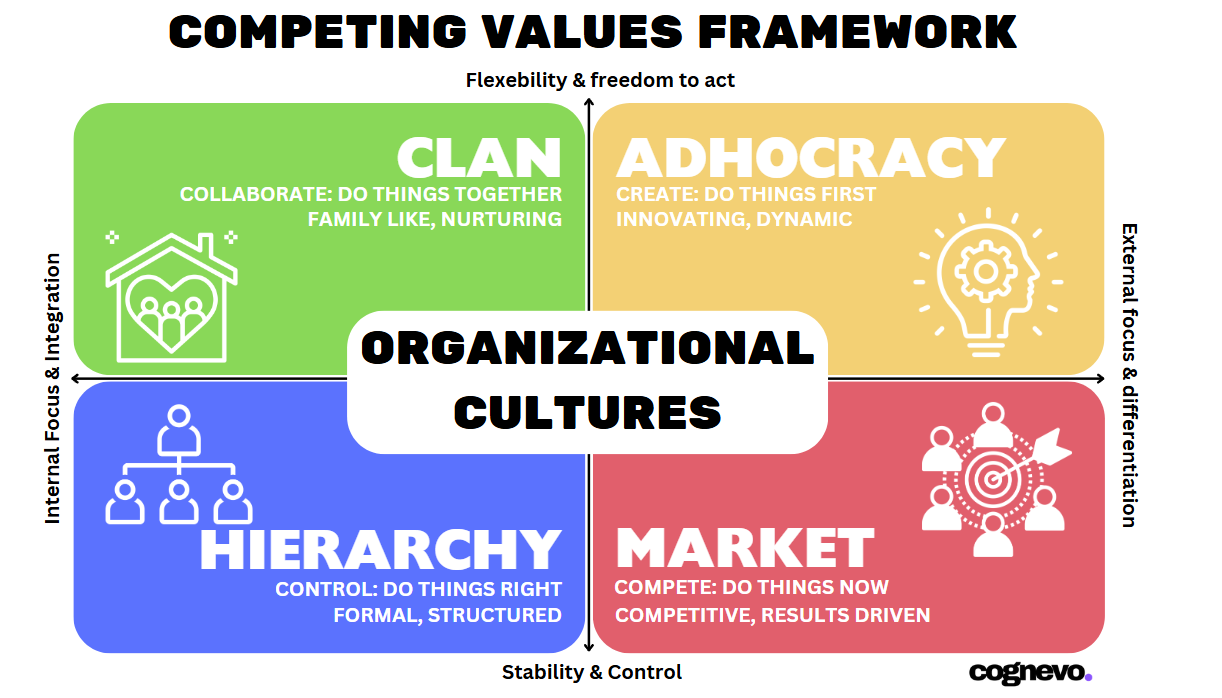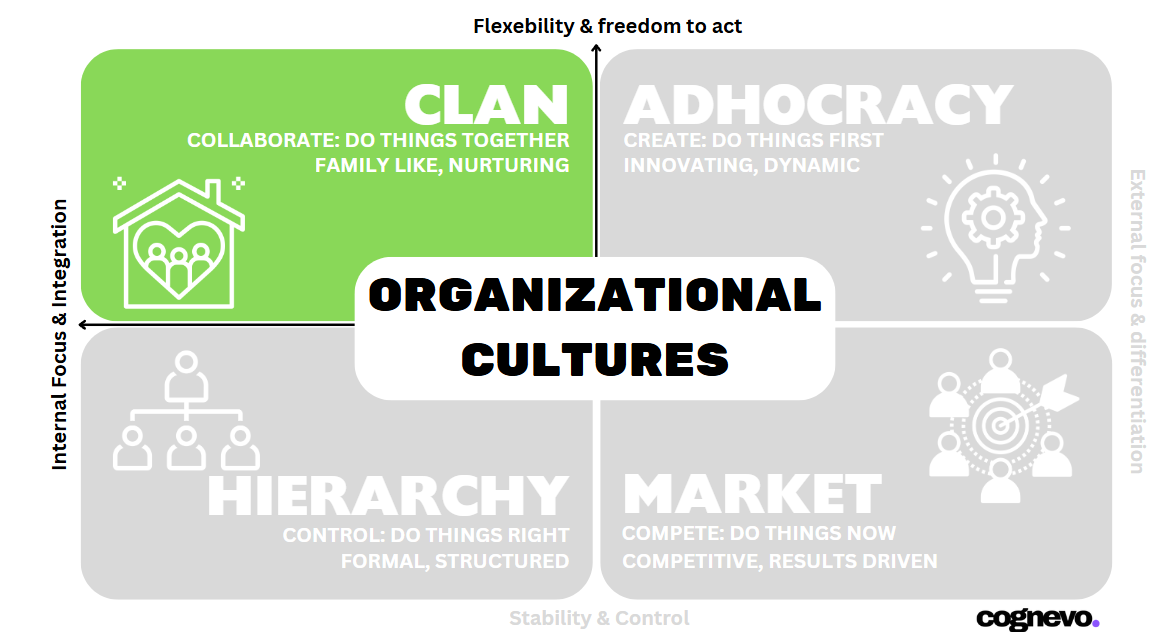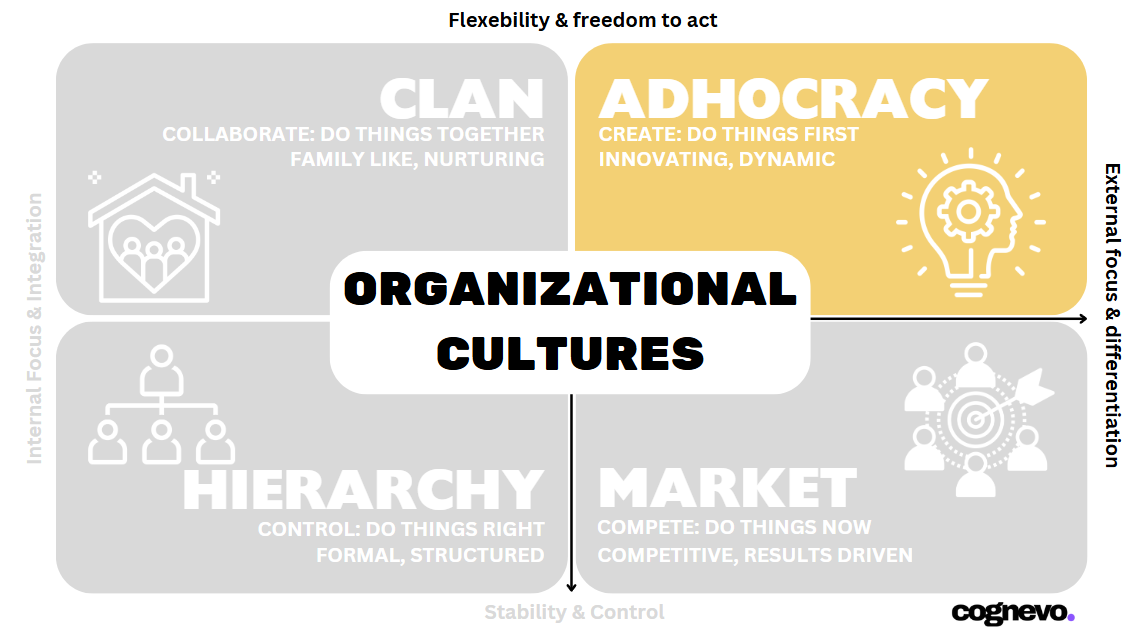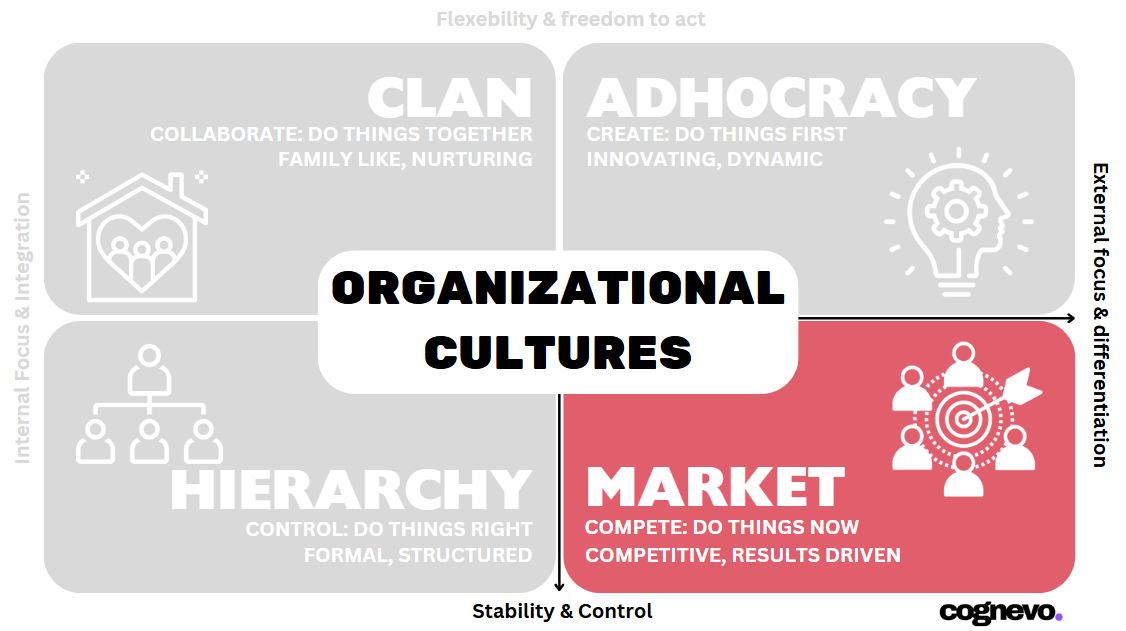Building a Thriving Team: A Hiring Manager's Guide to Company Culture
Understand the 4 Types and How They Shape Your Team
Building a Team of Rockstars: Why Your Company Culture Holds the Key
Ever feel like you're surrounded by idiots at work?
That feeling of banging your head against a wall because you just can't seem to connect with certain colleagues? Before you write them (or yourself) off as clueless, consider this: the real culprit might be a clash of company cultures.
💡Tip: Take the culture quiz to assess your culture archetype
Think about it. Just like there are different personality types, there are different company cultures too.
Each attracting and nurturing a distinct "tribe" of individuals. And sometimes, those tribes just don't speak the same language, no matter how hard they try.
Ever heard of the book Surrounded by Idiots? It breaks down those personality types into four colors:
Red: The "get it done" type - competitive, driven, loves results.
Yellow: The "ideas person" - social, enthusiastic, thrives on brainstorming and innovation.
Green: The "team player" - calm, caring, and values harmony and cooperation above all else.
Blue: The "systems thinker" - analytical, detail-oriented, loves structure and well-defined processes.
Now, imagine those colors painting the walls of entire companies!
That's company culture at play. This article explores the four main types, each reflecting those distinct personality colors:
Clan Culture: Warm and collaborative like the Greens, it's all about teamwork and feeling like a family.
Adhocracy Culture: Fast-paced and innovative like the Yellows, it's a haven for creative brainstorming and pushing boundaries.
Hierarchy Culture: Structured and process-driven like the Blues, it values efficiency and well-defined roles.
Market Culture: Results-oriented and competitive like the Reds, it's all about exceeding targets and coming out on top.
Clan Culture: Where Everyone Feels Like Family
Imagine a company where everyone feels like they belong. Where teamwork isn't just encouraged, it's the very heartbeat of the organization. That's the essence of Clan Culture—a collaborative and nurturing environment often compared to a big, (hopefully) functional family. Think of it as the company equivalent of Erikson’s Green personality type: empathetic, supportive, and driven by a deep sense of community.
Clan culture team dynamics
Teamwork is Everything: Forget silos—collaboration is the name of the game. Employees are encouraged to share ideas freely, work together towards common goals, and celebrate each other's successes.
Open Communication is the Norm: Leaders are approachable and transparent, feedback is valued and acted upon, and employees feel comfortable voicing their opinions without fear of judgement.
Employee Growth is Championed: Learning and development are prioritized, with mentorship programs, training opportunities, and a focus on nurturing talent from within.
Work-Life Harmony is Encouraged: While results matter, Clan Cultures understand that burnt-out employees don't thrive. Expect a healthy respect for personal time and a focus on employee well-being.
Attracting & Retaining Clan Culture Talent
Showcase Your Human Side: Ditch the corporate jargon and let your company's warmth shine through in job descriptions and during interviews. Highlight your commitment to teamwork, professional development, and work-life balance.
Seek Out Natural Collaborators: Look for candidates who demonstrate excellent communication skills, a genuine interest in others, and a track record of working effectively in team environments.
Nurture a Sense of Belonging: Invest in team-building activities, social events, and initiatives that foster a strong sense of community within the workplace.
Empower Through Autonomy and Trust: Provide clear expectations but also give employees the freedom and flexibility to approach challenges in ways that align with their strengths.
The Clan Culture Advantage:
Clan cultures excel at attracting and retaining talent, fostering loyalty, and creating a highly engaged workforce.
When employees feel heard, valued, and supported, they’re more likely to go the extra mile, leading to increased innovation, productivity, and job satisfaction.
The Clan Culture Pitfall:
Potential for Slow Decision-Making: The emphasis on consensus-building can sometimes hinder agility and slow down the decision-making process.
Resistance to Change: The strong focus on internal harmony may create resistance to change, especially if it's perceived as disruptive to the established culture.
Adhocracy Culture: Where Innovation Ignites
Forget the rulebook. In an Adhocracy Culture, it’s all about breaking boundaries, challenging the status quo, and embracing the unknown.
Imagine the company as a vibrant, fast-moving startup, even if it's a long-established corporation. It's where Erikson’s Yellow personality type feels most at home: buzzing with ideas, thriving on creativity, and always seeking the next big breakthrough.
Two Key Dimensions of Adhocracy Culture:
External Focus: Adhocracies are obsessed with being ahead of the curve, constantly scanning the horizon for emerging trends and opportunities. They're laser-focused on pushing boundaries and disrupting industries.
Flexibility and Freedom to Act: Forget rigid hierarchies and slow-moving bureaucracy. Adhocracies empower employees at all levels to experiment, take initiative, and turn bold ideas into reality. Their mantra? Create: Do things first!
Adhocracy Culture Dynamics
Risk-taking is rewarded: Failure isn't feared but seen as a valuable learning opportunity on the path to success.
Innovation is celebrated: From brainstorming sessions to dedicated "innovation labs," these companies live and breathe creativity.
Flat organizational structures: Adhocracies minimize bureaucracy and empower employees to make decisions without layers of approval.
Agile and adaptable: These companies embrace change and pivot quickly to seize new opportunities or navigate unexpected challenges.
Attracting and Retaining Adhocracy Talent:
Showcase Your Cutting-Edge Culture: Highlight your company's innovative projects, risk-taking mentality, and commitment to pushing boundaries in your employer branding and job descriptions.
Seek Out Entrepreneurial Spirits: Look for candidates who demonstrate a passion for innovation, a willingness to challenge norms, and a knack for creative problem-solving.
Provide Autonomy and Ownership: Empower employees to take ownership of their projects, make decisions, and see their ideas come to life.
Foster a Culture of Continuous Learning: Encourage experimentation, provide access to the latest tools and technologies, and celebrate both successes and "learning moments" from failures.
The Adhocracy Advantage:
Rapid Innovation and Growth: By fostering a culture of experimentation, Adhocracies are often first to market with groundbreaking products and services.
Attracting and Retaining Top Talent: Creative and driven individuals are naturally drawn to environments where their ideas are valued and they have the freedom to make an impact.
Adaptability in Dynamic Markets: Their ability to pivot quickly allows Adhocracies to thrive in industries characterized by rapid change and disruption.
The Adhocracy Pitfall:
Potential for Chaos and Burnout: The fast-paced, ever-changing nature of Adhocracies can lead to burnout if not managed carefully.
It's important to establish clear priorities and ensure employees have the resources and support they need to thrive in this dynamic environment.
💡Ready to Take the culture quiz to assess your culture archetype?
Market Culture: It’s all About Performance
In the fast-paced arena of Market Culture, it’s all about results. This is where ambitious, driven individuals thrive on competition, exceeding targets, and achieving ambitious goals. Think of it as the corporate embodiment of Erikson’s Red personality type: assertive, results-oriented, and laser-focused on coming out on top.
Two Key Dimensions of Market Culture:
External Focus: Market Cultures are obsessed with staying ahead of the competition. They're constantly monitoring market trends, analyzing competitor strategies, and finding new ways to win market share.
Stability & Control: While outwardly dynamic, Market Cultures rely on internal stability and control to ensure consistent performance. They value well-defined processes, clear metrics, and a strong emphasis on accountability. Their mantra? Compete: Do things now!
Market Culture Dynamics
Performance is King: Key performance indicators (KPIs) and metrics are closely tracked and celebrated. High achievers are publicly recognized and rewarded.
Competition is Encouraged (Even Internally): A healthy dose of competition among individuals and teams is seen as a driver of excellence.
Clear Goals and Expectations: Everyone knows what's expected of them, and there's a strong focus on achieving tangible outcomes.
Process-Oriented: While results matter most, Market Cultures rely on efficient processes and systems to drive consistent performance.
Attracting and Retaining Market Culture Talent:
Showcase Your Winning Spirit: Highlight your company's achievements, market leadership, and commitment to excellence in your employer brand messaging.
Seek Out Achievers: Look for candidates with a proven track record of success, a strong work ethic, and a desire to make a measurable impact.
Offer Competitive Compensation and Benefits: Market Cultures understand the importance of attracting top talent and are willing to offer competitive salaries, bonuses, and other perks.
Provide Clear Career Paths and Growth Opportunities: Ambitious individuals want to know they have room to grow and advance within the organization.
The Market Culture Advantage:
Strong Financial Performance: The focus on results and efficiency often translates to higher profits, market share growth, and a competitive advantage.
Attracting High Performers: Ambitious, results-oriented individuals are naturally drawn to Market Cultures where they can excel and be rewarded for their achievements.
Adaptability and Responsiveness: While valuing stability, Market Cultures are also adept at responding quickly to market shifts and competitor moves.
The Market Culture Pitfall:
Potential for Burnout and Attrition: The relentless focus on performance can lead to stress, burnout, and high employee turnover if not managed effectively.
Risk of Short-Term Thinking: The emphasis on immediate results can sometimes overshadow long-term vision and strategic thinking.
Hierarchy Culture: Stability and Order
Hierarchy Culture culture prioritizes stability, control, and efficiency above all else, operating like a well-oiled machine with a place for everything and everything in its place.
Think of it as the corporate embodiment of Erikson’s Blue personality type: detail-oriented, methodical, and valuing structure and order.
Two Key Dimensions of Hierarchy Culture:
Stability & Control: Hierarchy Cultures thrive on predictability. They establish clear rules, regulations, and procedures to ensure consistency, minimize risk, and maintain a sense of order.
Internal Focus: Their primary focus is on optimizing internal processes and systems to maximize efficiency and productivity. They value smooth operations, clear lines of authority, and a strong sense of accountability. Their mantra? Control: Do things right!
Hierarchy Culture Dynamics
Clearly Defined Roles and Responsibilities: Everyone knows their place within the hierarchy and what's expected of them.
Emphasis on Rules and Procedures: Processes are documented and followed meticulously to ensure consistency and minimize errors.
Multi-Layered Organizational Structure: A clear chain of command dictates decision-making and information flow.
Value Placed on Experience and Seniority: Promotion and advancement are often tied to tenure and a proven track record within the organization.
Attracting and Retaining Hierarchy Culture Talent:
Showcase Your Stability and Structure: Highlight your company's long-term vision, well-established processes, and commitment to providing a predictable work environment.
Seek Out Process-Oriented Individuals: Look for candidates who value structure, demonstrate attention to detail, and excel at following established procedures.
Offer Clear Career Paths and Development Opportunities: Provide opportunities for growth within the existing hierarchy, emphasizing training and skill development that aligns with established roles.
Lead with Clarity and Consistency: Communicate expectations clearly, provide regular feedback, and ensure that decisions are made in a transparent and consistent manner.
The Hierarchy Culture Advantage:
Efficiency and Predictability: Well-defined processes and a clear chain of command can lead to streamlined operations, reduced errors, and increased efficiency.
Stability and Reduced Risk: The emphasis on control and risk mitigation can create a sense of security and stability for both employees and stakeholders.
Clear Career Trajectories: Employees often appreciate the well-defined career paths and opportunities for advancement within the established hierarchy.
The Hierarchy Culture Pitfall:
Resistance to Change: The strong emphasis on stability and control can make Hierarchy Cultures resistant to change and slow to adapt to new market conditions or customer needs.
Bureaucracy and Slow Decision-Making: The multi-layered organizational structure can lead to slow decision-making processes as approvals are required at various levels.
Finding the Right Fit: Unlocking the Power of Company Culture
And there you have it! We've explored the four primary company cultures, each with its own unique personality, advantages, and potential pitfalls:
Clan Culture: The close-knit family, built on collaboration, nurturing relationships, and shared values.
Adhocracy Culture: The innovation hub, where risk-taking, creativity, and rapid iteration reign supreme.
Market Culture: The competitive arena, driven by ambitious goals, measurable results, and market dominance.
Hierarchy Culture: The well-oiled machine, defined by clear processes, stability, and a strong emphasis on control and efficiency.
As a hiring manager, understanding these cultures is essential for building high-performing teams. But putting this knowledge into practice during the fast-paced hiring process is easier said than done.
Ready to go beyond theory and make data-driven hiring decisions that align with your company culture?
Take our quick Culture Fit Quiz by clicking here
It only takes a few minutes to uncover valuable insights about your cultural DNA.
Hire Smarter with Real-Time Culture Fit Insights
Empower your team to make data-driven hiring decisions consistently, without the guesswork.
Don't just analyze culture - put it at the heart of your hiring process.
Join Cognevo and discover how our AI Interview Co-Pilot can help you:
Get instant interview feedback and data-driven insights.
Reduce bias and make more objective hiring decisions.
Reclaim your time with AI-automated summaries and candidate scoring.
Request to join Cognevo and empower your team!








